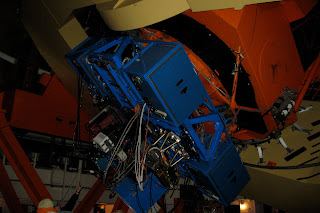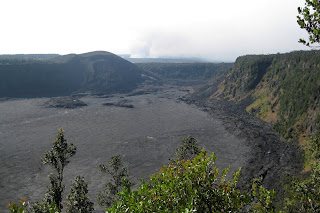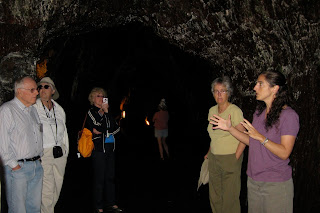
Here is Michael Kuranoff's group photo taken on day two in Hosmer Grove.

Here is something I came across while fact checking for this blog. This is a National Oceanic and Atmospheric Administration (NOAA) picture of the Pacific Ocean. It shows the line of underwater mountains created as the Pacific tectonic plate moved over the Hawaii hotspot. The line called the Hawaiian-Emperor seamount chain formed over a period of about 80 million years. There is a bend in the chain about 45 million years ago when the tectonic plate changed direction.
In the morning on Thursday, January 21 we left our hotel for Kona International Airport. No walls, of course. The airport check-in procedure was like going through a labyrinth. You had to go through a line on the right, then back past that to a line on the left. At one of the checkpoints a USDA sniffer checked for food items in my luggage. At the TSA inspection location one person forgot to collect his loose change. The TSA employee, holding the coin container, called him back, "Sir, we are not allowed to accept tips."
My first flight to San Francisco was billed as US Airways flight 6010 but it was actually United Airlines flight 56. It was on a Boeing 767. Due to recent heavy rains in California many people's flights were delayed. We just circled for a few minutes before landing.
My second flight was from San Francisco to Newark on a real US Airways plane, an almost full Airbus 319. Again, at the airport, announcements encouraged people to buy food before boarding. On board the only way to buy food was with a credit card. The flight attendants had a hand-held device through which they swiped the credit card. I got a flight attendant to smile when I asked, "When you are not swiping credit cards through that thing, can you play solitaire on it?" The plane landed on time at about 7:00 am. From the airport I took the monorail, New Jersey Transit, and a taxi and found everything at home just as I had left it.


Images keep popping into my head. My first helicopter ride in Hilo on the island of Hawaii. The trip up the side of Hualalai Volcano in the Pinzgauer.


The 6 foot diameter primary mirror of the Pan-STARRS telescope on Mount Haleakala. The back of the 33 foot diameter primary mirror of one of the Keck Telescopes on Mauna Kea.


Sunrise at the summit of Mount Haleakala. Sunset at the top of Mauna Kea.

And Mount Kilauea, home of Pele, Hawaiian goddess of fire.
The whole expedition was fantastic. This was due, of course, to all the hard work by Michael Shara, Michael Kuranoff, the people at AMNH Expeditions, the people at Siemer and Hand Travel, and all of our guides. Most importantly, it was my fellow travelers who made the trip such a success.









































